f85v MIDDLE
|
 |
| f85v, middle. Voynich Manuscript. Credit: Beinecke Rare Book and Manuscript
Library, Yale University. |
This is the other image on f85v and
has a central image of the Moon. I suggest this image is also the subject of
SN 1572 and suggest that the date of 11th November 1572 can be found within the
image.
|
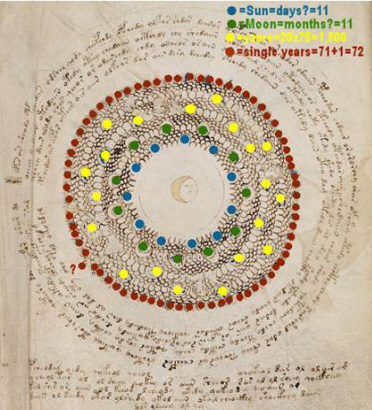 |
 |
| f85v, middle. Voynich Manuscript. Credit: Beinecke Rare Book and Manuscript
Library, Yale University. Overlay by P. Han showing suggested
connection of the image to the date 11/11/1572 |
f85v, middle. Voynich Manuscript. Credit: Beinecke Rare Book and Manuscript
Library, Yale University. Suggested Circle/dot=day, crescent Monn=month,
outher circles=single years. |
The blue marks in the innermost circle
mark 11 larger marks like semi-circles with dots in the centre, I suggest
these represent the sun and therefore days. Day =11.
The green marks in the next circle mark circles with the appearance of
crescent Moons, I suggest these are months. Month = 11/November.
The outermost circle has alternate light and dark semi-circles that total 71
or 72 placing the missing light one behind the object held in the right hand
by the figure on the left. I suggest this marks the 72 part of 1572.
The marks between the green “month” markers and red “year” markers contain a
number of larger dark semi-circles, which number 19, if there is one extra
marker hidden behind a figure as suggested by the orange dot this would make
20 markers. If 20 represents 1,000 then each large yellow and the orange
marker would represent 50 years.
This would leave the 500 part of 1572 to be accounted for. There are many
markers left and some part may represent 500 but overall 11/11/1572 fits
along the lines of what is found in these circular markers more than another
unconnected arbitrary date when the subject matter already suggested for
f85v, SN 1572, occurred on 11/11/1572.
 |
 |
| f85v, middle. Voynich Manuscript. Credit: Beinecke Rare Book and Manuscript
Library, Yale University. Overlay by P. Han showing page marker and
figures as markers. |
Credit: Redshift6. Star map
11/11/1572 over Scania (formerly in
Denmark). Overlay by P. Han showing comparison of star map with f85v,
middle. |
The image above left shows the only one
clear marker on the page, shown in red. The blue lines mark the position of the
figures and the pointing hand of the figure on the right. Using the figures as
directional markers (as on f85v) and viewing SN 1572 from where the Moon is
located, there is a match for the markers. The main red marker going through the
Moon would represent the path of the Moon and the blue line up with the horizon
and SN 1572 in relation to the Moon. The red dotted line shows the marker from
the Moon to SN 1572. The red marker also passes through SN 1604 in one direction
and very close to SN 1504 in the other direction, this may be the reason for the
“Moon orbit” marker.
The figures themselves are very non-descript like the figures on f85v and in
this role they may represent directional page markers. They also however hold
distinct objects suggesting they may have a duel role and as images also
represent constellations.
I suggest the figure to the top still “represents” Cassiopeia, holding a palm
leaf and the orb of the new star (SN 1572). The figure on the right is pointing
rather than the one on the left and I suggest this still represents Cepheus but
from the other side, holding the disc of the new star next to an unusual semi
circle which unlike the others on that circle has a rainbow type appearance. I
suggest this represents the Celestial Zero Meridian, next to which the supernova was
located just above Cepheus, the other hand pointing to the true position of the
new star. The figure on the bottom I suggest may represent Capricorn, holding a
goats? Horn and a misshapen disc. The figure on the bottom may represent
Aquarius holding a container in one hand, with water flowing from the other
hand. These constellations do not all lie on the Celestial Zero Meridian like
those on the f85v “sun” image but they are the constellations most closely
related to the location of the Moon and SN 1572 from this view of the sky and as
I have suggested elsewhere is the location of SN 5 BC and its possible
connection to the star of Bethlehem as subject matter in the manuscript.
Cepheus is to the right of Cassiopeia and below Aquarius is to the left of
Capricorn.
|
 |
 |
|
Credit: Redshift6. Star map
11/11/1572 over Scania (formerly in
Denmark). Overlay by P. Han showing close up detail of star map image
above |
f85v, middle, cropped. Voynich Manuscript. Credit: Beinecke Rare Book and Manuscript
Library, Yale University. Overlay by P. Han showing alignment of
figures compared to star map. |
The figures are shown below in detail,
clockwise from the top of the image.
|
 |
|
f85v, middle,
cropped. Voynich Manuscript. Credit: Beinecke Rare Book and Manuscript
Library, Yale University.
Suggest top figure is shown
holding Palm leaf? and orb of the new star. |
|
 |
|
f85v, middle,
cropped. Voynich Manuscript. Credit: Beinecke Rare Book and Manuscript
Library, Yale University.
Suggest figure on right is
shown holding the orb of the new star next to the Celestial Zero
Meridian and pointing to its true position. |
|
 |
|
f85v,
middle, cropped. Voynich Manuscript. Credit: Beinecke Rare Book and Manuscript
Library, Yale University.
Suggest bottom figure
shown holding a goats? horn and a disc? = SN 5 BC? |
|
 |
|
f85v, middle,
cropped. Voynich Manuscript. Credit: Beinecke Rare Book and Manuscript
Library, Yale University.
Suggest figure on left
shown holding a container, with water? flowing from the other hand.
|
Taurus and SN 1054 as seen from the star
map above seem to be quite far out of the picture. The Moon has eyes but it is
quite hard to tell where the one on the right is looking, the one on the left
appears to be a line and the face is looking to the right. The dark side of the
Moon is to the left, it appears to be looking along it’s orbit, Taurus and SN
1054 are close to the Moon’s orbit but away from this part of the sky. Unexpectedly SN 1604 the supernova seen by Kepler is directly in the path of the
Moon. This may be coincidental and just represent the orbit of the Moon, but it
raises the question as to whether just SN 1054 and SN 1572 or in fact many “new
stars” could be recorded in the manuscript, and whether this is a direct cause
for some of the manuscript pages and particularly the missing zodiac pages to
have been removed.
 |
 |
| 85v, middle, cropped. Voynich Manuscript. Credit: Beinecke Rare Book and Manuscript
Library, Yale University. Overlay by P. Han showing eye marker for
the Moon. |
Credit: Redshift6. Star map
11/11/1572 over Scania (formerly in
Denmark). Overlay by P. Han showing alignment of the Moon and SN 1604. |
Below the image shows the location of the
supernovae as transferred onto the manuscript image from the star map, the Moon
in this scenario appears to be looking at SN 5 BC in Capricorn.
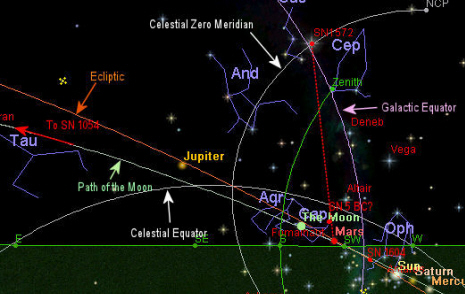 |
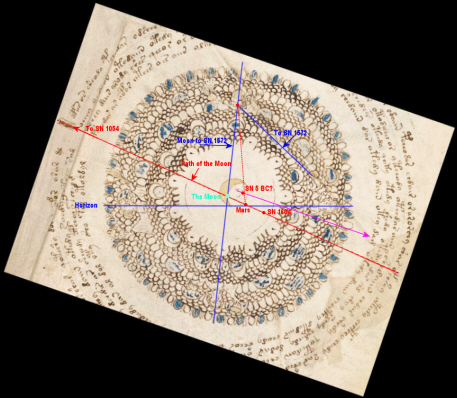 |
|
Credit: Redshift6. Star map
11/11/1572 over Scania (formerly in
Denmark). Overlay by P. Han showing position of SN 1572 in relation to
SN 5 BC. |
85v, middle, cropped. Voynich Manuscript. Credit: Beinecke Rare Book and Manuscript
Library, Yale University. Overlay by P. Han showing suggested
comparisons of the markers to the star map and the positions of SN 1572
and SN 1054. |
The view of the sky indicated by the f58v
Moon folio also appears to encompass most of the known recorded naked eye
supernova within it’s view, with those in Cassiopeia and Taurus found on the
f58v “Sun” folio. The Supernova in Vela (9,000 BC) is unlikely to be in Chinese records but
lies just out of sight below Centaurus. In this view from the South which
included the Moon, the supernovae which I have put forwards as the main topics
in the Voynich Manuscript are out of view suggesting that there is another
important topic which may be a concern of the missing pages. Assuming SN 1604’s
relation to the Moon’s orbit is coincidental (there do not seem to be other
references to this or the well recorded SN 1006 either) and the Moon’s eyes are
indicating its orbit or looking at Virgo as suggested to appear in the image on
f85v “Sun” folio, or even at Capricorn, then this leaves one item of interest
above the horizon from this viewpoint. The supernova which is thought to lie in
Capricorn has been suggested may be the “star of Bethlehem” and aside from any
belief or otherwise in this as a real object, it’s discussion alone within a
manuscript may be enough to lead to the removal of pages concerning it and for
the topic of “new stars” and challenging the “immutability”of the heavens
require writing in a hidden form. Tycho and Kepler had both stated that one of
the only previous new stars to have ever occurred was the Star of Bethlehem. The
Jesuit missionary J. F. Foucquet in 1729 on translating Chinese astronomical
records suggested That the “hui-hsing” (bushy star) recorded by the Chinese in
Capricorn in 5 BC may have actually been a nova due to its lack of recorded
movement over the 70 days it was recorded. Since the 1950’s the connection of
this Chinese record of a “guest star” to the Star of Bethlehem has been a matter
of debate along with many other theories.
|
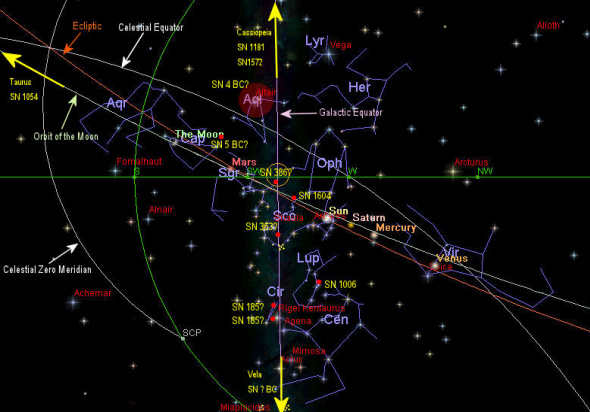 |
|
Credit: Redshift6. Star map
11/11/1572 over Scania (formerly in
Denmark). Positions of all known naked eye supernovae marked
in European style horizon based star map. |
Below the supernovae shown on a Chinese
style, North Pole centred star map. In this view SN 1054 and SN 1604 lie on
opposite side of the North Pole and SN 1572 and SN 1181 are placed near the
Pole.
|
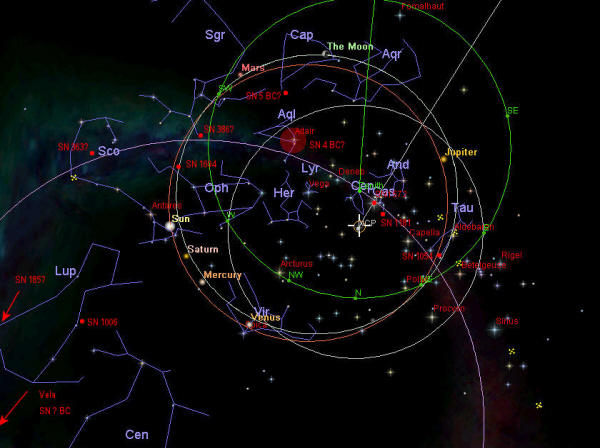 |
|
Credit: Redshift6.
North Pole centred star map
11/11/1572 over Scania (formerly in
Denmark). Positions of all known naked eye supernovae marked. |

Copyright © 2010 P. Han
















